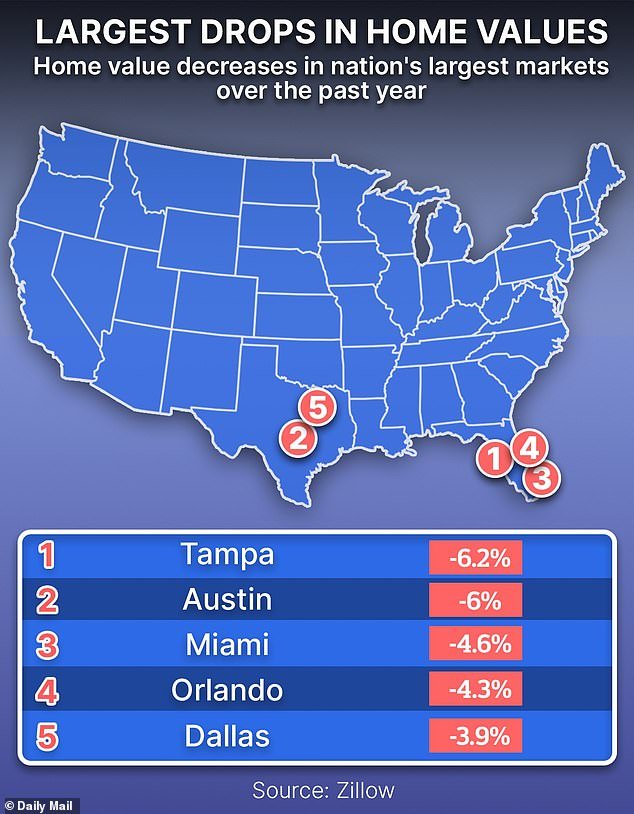Home prices are falling in half of the nation’s largest markets, a new report reveals —sparking fears that a housing crash is looming.
Sellers are slashing prices at record rates to to lure hesitant buyers put off by soaring mortgage rates and economic uncertainty.
In July alone, 27.4 percent of listings had a price cut — the highest rate ever recorded in Zillow’s monthly data going back to 2018.
It helped push prices down year-over-year in 25 of the 50 largest US cities. Most were in the South and West.
Florida and Texas, in particular, are home to former boomtowns where prices have fallen at the quickest rate over the past year.
Tampa prices are down 6.2 percent, Austin 6 percent, Miami 4.6 percent, Orlando 4.3 percent and Dallas 3.9 percent, according to Zillow.
‘Metros where price corrections are steepest are among those with the largest increase in inventory compared to before the pandemic,’ said Kara Ng, senior economist at Zillow.
In the South in particular, the pandemic housing boom is now flipping into a bust as a result of too many homes being built, leading to supply outweighing demand.

All of the top five metros for price drops over the last year — except Miami — are among the top places for home building permits between 2020 and 2024.
When demand for homes surged during the pandemic, builders were able to respond fastest in these areas because there were fewer land-use restrictions.
But these areas are now seeing a glut of inventory, as homes flood the market but buyers are not biting.
In Florida, in particular, homeowners are struggling to sell amid a growing condo crisis and soaring insurance rates due to the threat of natural disasters.
Price cuts are more common in the South and the Mountain region, according to Zillow, as homeowners desperately try to offload properties.
In some areas where home prices are falling, this is restoring a tiny chunk of affordability which was lost in the early pandemic run-up in prices.
But buyers are likely still running into affordability walls in expensive western coastal metros like San Francisco and San Diego.
More wealthy home shoppers, however, are able to gain leverage in negotiations as high costs and economic uncertainty have pushed their competition to the sidelines.

Home values have plunged 6.2 percent in the last year in Tampa, Florida

The pandemic-era property boom is beginning to level out in cities such as Austin, Texas

Home values have plunged in Miami, Florida, as buyers remain on the sidelines

‘Metros where price corrections are steepest are among those with the largest increase in inventory compared to before the pandemic,’ said Kara Ng, senior economist at Zillow
While crash fears are escalating in some areas of the US, others are seeing home prices continue to grow.
Home values grew over the last year in 25 major markets, mostly in the Midwest and Northeast.
‘Demand is high — especially in affordable areas — but building restrictions put a damper on new and higher-density projects,’ said Kara Ng.
‘Sellers have few options to move up to, and existing inventory is still below pre-pandemic averages in many metros.’
Cleveland, Ohio, saw a 4.7 percent increase in home values in the year to July — the highest in the nation.
Hartford, Connecticut, meanwhile, saw a 4.5 percent increase, Louisville, Kentucky, saw home values go up 3.9 percent, and Detroit, Michigan saw an increase of 3.8 percent.
Home values in Buffalo, New York, also went up by 3.7 percent over the year.
However, even these gains are modest compared to the rampant double-digit growth seen three or four years ago.

Miami in FL has seen prices fall 4.6 per cent
It comes after Zillow reversed its forecast earlier this year, predicting that the US housing market would see overall home values decrease in 2025.
Zillow economists delivered a 12-month forecast in May that projected that US home prices on average will fall by 0.9 percent between April 2025 and April 2026.
This would mark the first overall dip in values since 2011.
It is a marked change from the real estate company’s prior prediction for this year, which had home values climbing by 2.9 percent.

